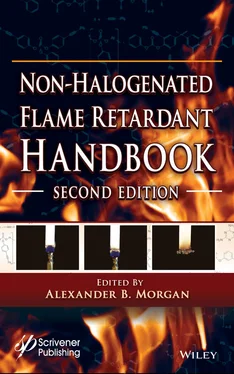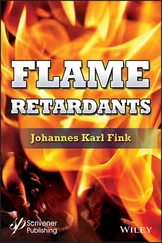1 Cover
2 Title
3 Copyright
4 Preface to the 2 ndEdition of the Non-Halogenated Flame Retardant Handbook
5 1 Regulations and Other Developments/Trends/Initiatives Driving Non-Halogenated Flame Retardant Use 1.1 Regulatory History of Halogenated vs. Non-Halogenated Flame Retardants 1.2 Regulations of Fire Safety and Flame Retardant Chemicals 1.3 Current Regulations 1.4 Fire Safety and Non-Fire Safety Issues Requiring Non-Halogenated Flame Retardants 1.5 Regulatory Outlook and Future Market Drivers References
6 2 Phosphorus-Based Flame Retardants 2.1 Introduction 2.2 Main Classes of Phosphorus-Based Flame Retardants 2.3 Red Phosphorus 2.4 Ammonium and Amine Phosphates 2.5 Metal Hypophosphites, Phosphites and Dialkyl Phosphinates 2.6 Aliphatic Phosphates and Phosphonates 2.7 Aromatic Phosphates and Phosphonates 2.8 Aromatic Phosphinates 2.9 Phosphine Oxides 2.10 Phosphazenes 2.11 Environmental Fate and Exposure to Organophosphorus FRs 2.12 Conclusions and Further Trends References
7 3 Mineral Filler Flame Retardants 3.1 Introduction 3.2 Industrial Importance of Mineral Flame Retardants 3.3 Overview of Mineral Filler FRs 3.4 Working Principle of Hydrated Mineral Flame Retardants 3.5 Thermoplastic and Elastomeric Applications 3.6 Reactive Resins/Thermoset Applications 3.7 Conclusion, Trends and Challenges References
8 4 Intumescence-Based Flame Retardant 4.1 Introduction 4.2 Fundamentals of Intumescence 4.3 Intumescence on the Market 4.4 Reaction to Fire of Intumescent Materials 4.5 Resistance to Fire of Intumescent Materials 4.6 Conclusion and Future Trends References
9 5 Nitrogen-Based Flame Retardants 5.1 Introduction 5.2 Main Types of Nitrogen-Based Flame Retardants 5.3 Ammonia-Based Flame Retardants 5.4 Melamine-Based Flame Retardants 5.5 Nitrogen-Based Radical Generators 5.6 Phosphazenes, Phospham and Phosphoroxynitride 5.7 Cyanuric-Acid Based Flame Retardants 5.8 Summary and Conclusion References
10 6 Silicon-Based Flame Retardants 6.1 Introduction 6.2 Basics of Silicon Chemistry 6.3 Industrial Applications of Silicones 6.4 Silicon-Based Materials as Flame Retardant Materials 6.5 Mode of Actions of Silicone-Based Flame Retardants and Practical Use Considerations 6.6 Future Trends in Silicon-Based Flame Retardants 6.7 Summary and Conclusions References
11 7 Boron-Based Flame Retardants in Non-Halogen Based Polymers 7.1 Introduction 7.2 Major Functions of Borates in Flame Retardancy 7.3 Major Commercial Boron-Based Flame Retardants and Their Applications 7.4 Properties and Applications of Boron-Base Flame Retardants 7.5 Mode of Actions of Boron-Based Flame Retardants 7.6 Conclusions References
12 8 Non-Halogenated Conformal Flame Retardant Coatings List of Acronyms 8.1 Introduction to Conformal Coatings: The Role of Surface During Combustion 8.2 Fabrics 8.3 Porous Materials 8.4 Other Substrates 8.5 Future Trends and Needs References
13 9 Multicomponent Flame Retardants 9.1 The Need for Multicomponent Flame Retardants 9.2 Concepts 9.3 Combination with Fillers 9.4 Adjuvants 9.5 Synergists 9.6 Combinations of Different Flame Retardants 9.7 Combinations of Different Flame-Retardant Groups in One Flame Retardant 9.8 Conclusion References
14 10 Other Non-Halogenated Flame Retardants and Future Fire Protection Concepts & Needs 10.1 The Periodic Table of Flame Retardants 10.2 Transition Metal Flame Retardants 10.3 Sulfur-Based Flame Retardants 10.4 Carbon-Based Flame Retardants 10.5 Bio-Based Materials 10.6 Tin-Based Flame Retardants 10.7 Polymer Nanocomposites 10.8 Engineering Non-Hal FR Solutions 10.9 Future Directions References
15 Index
16 End User License Agreement
1 Chapter 3 Figure 3.1 Mass balance for bauxite and alumina in 2018 (all figures as alumina,... Figure 3.2 World consumption of ATH by markets, 2018 (%) [4]. Figure 3.3 Volume split within mineral filler flame retardants based on flame re...Figure 3.4 Three synthetic routes for the production of boehmites.Figure 3.5 Typical particle shapes according to R. Rothon [18].Figure 3.6 SEM of some alumimium hydrates: a) 4m 2/g precipitated ATH with “porou...Figure 3.7 PSD curves of fine precipitated ATH (left), ground ATH (middle) and c...Figure 3.8 Principle of powder rheometer and comparison of characteristic data f...Figure 3.9 TGA curves for hydromagnesite, huntite and a commercial blend (left) ...Figure 3.10 Water uptake of 4m 2/g ATH grades in EVA (61.3 wt.-% filler loading)....Figure 3.11 Heat conductivity as a function of ATH filling level in UP resin. In...Figure 3.12 Scheme of the processes involved during burning of a metal hydroxide...Figure 3.13 LOI in dependence of loading level in EVA (19 % VA-content).Figure 3.14 LOI in dependence of BET-surface area of metal hydroxide filler. 61....Figure 3.15 Smoke density over time of an UP resin loaded with increasing parts ...Figure 3.16 Smoke Rate Release over time measured by cone calorimeter at 50 kW/m...Figure 3.17 Heat Release Rate of plasticised PVC with increasing ATH load (at 50...Figure 3.18 Heat Release Rate (HRR) of EVA (19 %VA) filled with 61.3 wt.-% of me...Figure 3.19 Chemical working function of industrially most important coupling ag...Figure 3.20 Pyramid of commonly applied cable standards for buildings according ...Figure 3.21 Tensile strength (TS, broken line) and elongation at break (E@B) in ...Figure 3.22 Impact resistance, LOI and UL94V rating of PBT compound containing 2...Figure 3.23 MVR of PBT compounds (20 % glass fibre) in dependence of FR-composit...Figure 3.24 Influence of glass fibre reinforcement on LOI for different resin ty...Figure 3.25 Sketch for the hand lamination (left) and SMC process.Figure 3.26 Relative viscosity of UP filled with different ATH and increasing fi...
2 Chapter 4Figure 4.1 Number of publications (all types) and patents (extracted from the da...Figure 4.2 Intumescent polylactide (PLA) during a cone calorimeter experiment. N...Figure 4.3 (a) HRR curves as a function of time of intumescent PP (external heat...Scheme 4.1 Chemical reaction occurring during the expansion of silicates.Figure 4.4 Intumescent silicate-based coating prepared in a furnace at high temp...Figure 4.5 (a) viscosity and swelling as a function of temperature of an epoxy-b...Figure 4.6 Internal structure of an intumescent char observed by X-ray tomograph...Figure 4.7 Snapshots as a function of time of a burning intumescent epoxy-based ...Figure 4.8 Melabis and b-MAP synthesis.Figure 4.9 Synthesis of melamine salts of pentaerythritol phosphate (MPP or b-MA...Figure 4.10 Phosphorus-nitrogen intumescent flame retardant.Figure 4.11 Synthesis of macromolecular triazines derivatives as char former for...Figure 4.12 Reaction scheme for the calcium salt formation in EBA copolymer cont...Figure 4.13 HRR as a function of time of pure TPU and TPU/FQ-POSS composite (ext...Figure 4.14 Cotton fabric coated with intumescent bi-layers subjected to vertica...Figure 4.15 HRR curves as a function of time for PU, PU/APP, PU/APP-MgO, PU/APP-...Figure 4.16 X-ray tomography picture of the inner structure of the char formed b...Figure 4.17 X-ray tomography picture of the inner structure of the char formed b...Figure 4.18 Standard fire test curves.Figure 4.19 Temperature as function of time on the backside of steel plate prote...Figure 4.20 (a–d), pictures as a function of time of the foaming specimens recor...Figure 4.21 (a) scheme of the H-TRIS bench-scale test and (b) analysis of an int...Figure 4.22 (a) Picture and scheme of the horizontal burner test bench (from Ref...Figure 4.23 Intumescent coating on steel plate during the burnthrough test (a) i...Figure 4.24 (a) Schematic description of the jetfire bench-scale test (note heat...Figure 4.25 Temperature as a function of time measured on the backside of steel ...Figure 4.26 Intumescent coating of geopolymer containing borax after fire testin...Figure 4.27 (a) X-ray tomography of GP foam showing the internal foamy structure...Figure 4.28 IPML before and after fire testing at the burnthrough test, delamina...
Читать дальше












